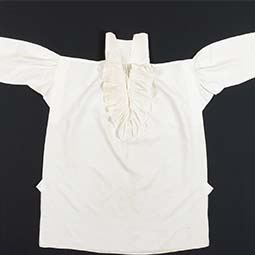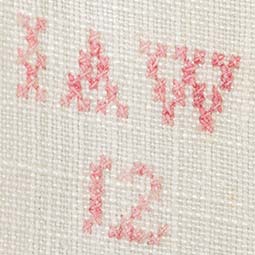Linen Shirt
In the eighteenth and nineteenth centuries, the shirt was a standard item of men’s clothing, but not every shirt was the same. This shirt is made of fine linen, suggesting higher cost. Shirts could be purchased ready-made or were often made by skilled enslaved seamstresses and tailors themselves. Accounts of textile orders intended for slave use document how dressing enslaved bodies was a strategy for controlling personal choice and enforcing a societal position of inferiority.
The widespread use of this type of garment, however, reveals a more complex story. Enslaved people reclaimed self expression through dress, wearing a wide variety of clothing that could be provided by enslavers, received second-hand, or purchased with their own funds. Adapting clothing to their own purposes, enslaved people crafted their personal appearances despite efforts to control, creating looks which could carry subtle but powerful messages of subversion and resistance.
The initials and number on the lower left of the shirt indicate that it was sent out to be washed and was one of at least twelve the owner possessed. This detail provides a glimpse into the many lives attached to this object, including its maker, wearer, and washer, and the many ways it could have been connected to slavery.
To learn more, visit: https://www.monticello.org/site/plantation-and-slavery/slave-clothing



